The Jewel Bug Nebula (NGC 7027) is a young planetary nebula located in the constellation Cygnus. It lies approximately 2,870 light years away. With an apparent magnitude of 10, it is one of the brightest planetary nebulae in the sky.
NGC 7027 is believed to be about 600 years old. The nebula has a highly intricate structure consisting of a thick, elongated, ellipsoidal shell of ionized gas surrounded by a large neutral cloud. The surrounding region has a distinctive morphology resembling a cloverleaf, with at least two pairs of lobes extending out from it.
A 2001 study reported extended bipolar X-ray emission from the nebula, detected by the Chandra X-ray Observatory. The emission is believed to be generated by the strong stellar wind from the central star or possibly from an unseen companion. The X-rays indicate remarkably high temperatures in the nebula’s central regions.
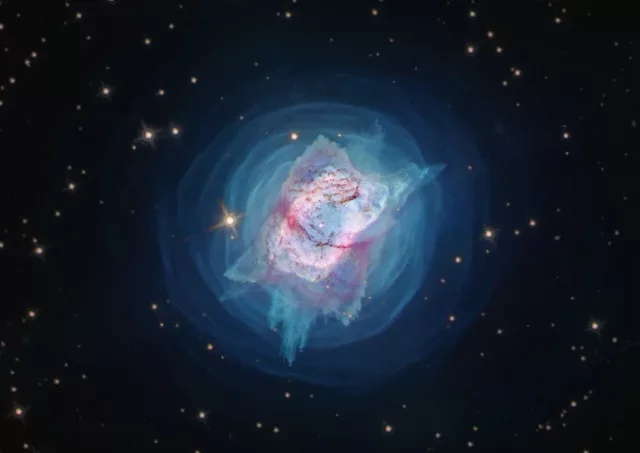
This image from the NASA/ESA Hubble Space Telescope depicts NGC 7027, or the “Jewel Bug” nebula. The object had been slowly puffing away its mass in quiet, spherically symmetric or perhaps spiral patterns for centuries — until relatively recently when it produced a new cloverleaf pattern. New observations of the object have found unprecedented levels of complexity and rapid changes in the jets and gas bubbles blasting off of the star at the centre of the nebula. Image: NASA, ESA, and J. Kastner (RIT)
Size
NGC 7027 has an apparent size of 16 by 12 arcseconds, which corresponds to a physical size of only 0.2 by 0.1 light years, or about 14,000 astronomical units across. It is one of the smallest planetary nebulae known, as well as one of the most studied. A study published in 1989 confirmed an expansion rate of 4.2 milliarcseconds per year for the nebula, with an expansion velocity of 17.5 km/s.
Luminosity
The total luminosity of the nebula is at least 5,500 solar luminosities, with some estimates going as high as 20,000 solar luminosities. The luminosity and temperature of the central star will decrease in the near future and, within the next 1,000 years, the star’s luminosity is expected to drop by a factor of 10, which will also affect nebular emission. In its current evolutionary stage, the nebula is illuminated by the intense ultraviolet radiation from the central white dwarf. The radiation lights up the region of gas surrounding the star. The hot gas in the inner region is surrounded by a cloud of cool hydrogen gas and dust that is only visible in infrared wavelengths.
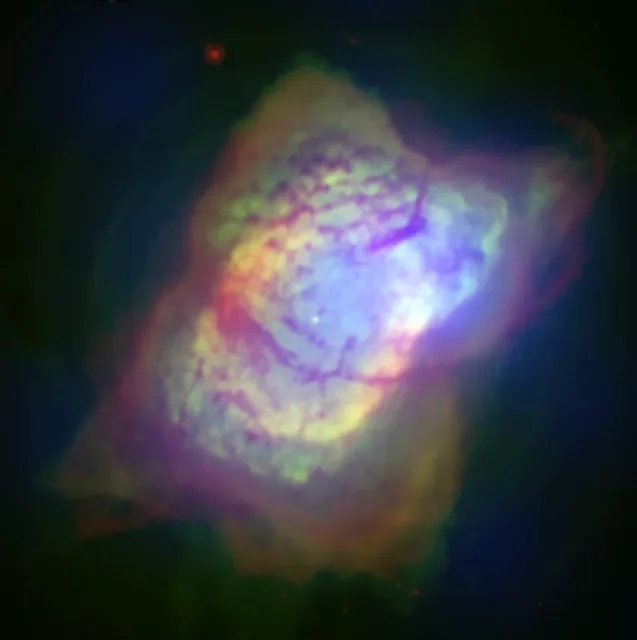
A bubble of 3 million degree Celsius gas with a length about a hundred times that of our solar system is shown in the image. NGC 7027 is the remains of a Sun-like star that has ejected much of its mass to expose its hot core. The X-rays are thought to be produced when a “fast” wind from the hot core collides with the “slow” wind that was ejected earlier during the star’s red giant phase. This collision heats the matter to several million degrees so that it glows in X-rays. Image: Chandra X-ray Observatory, NASA/CXC/RIT/J.Kastner et al.
Facts
The progenitor star of NGC 7027 is believed to have had an initial mass of at least 4 solar masses. In the last million years of its life, it underwent rapid mass loss before ejecting its outer shell and becoming a white dwarf. Now the star has an estimated mass of 0.7 solar masses. The nebula’s expanding halo is believed to have a mass of 3 solar masses, which is about 100 times more than the central region.
The Jewel Bug was discovered by the French astronomer Édouard Stephan in 1878. Stephan used a 31-inch reflector telescope at Marseille Observatory, the same instrument that he used to discover a number of other deep sky objects, including the group of interacting galaxies known as Stephan’s Quintet in Pegasus and the lenticular galaxy NGC 6027 in Serpens.
Stephan did not understand the nature of the nebula he had discovered. In the 1870s, he used the 31-inch reflector to measure the apparent diameter of stars. His discovery of the Jewel Bug was really a discovery of a star’s outer atmosphere.
The Jewel Bug was independently discovered by the Reverend Thomas William Webb on November 14, 1879. Webb, a British astronomer best known for his guide Celestial Objects for Common Telescopes (1859), described his discovery, “Planetary, like a [magnitude] 8.5 star, about 4”.” Even though he used the same term that we use today, Webb did not know what he had discovered either. The term “planetary nebula” was used by William Herschel about a century before Webb’s discovery and it became widely used by astronomers to describe round objects that appeared to have disks similar to those of planets. Herschel initially believed these objects were stars with orbiting material that was condensing into planets. The true nature of planetary nebulae was not fully understood until the early 20th century.
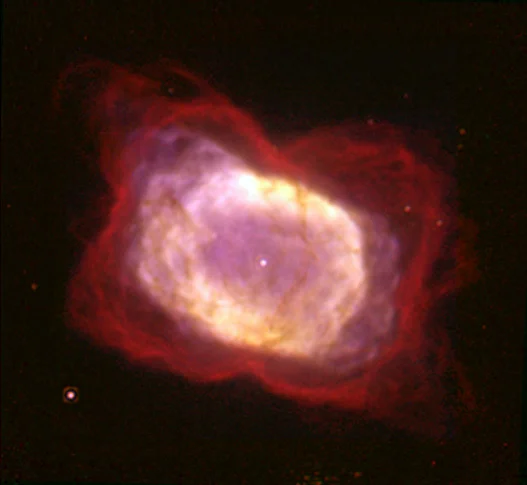
The Hubble Space Telescope’s Near Infrared Camera and Multi-Object Spectrometer (NICMOS) has captured a glimpse of a brief stage in the burnout of NGC 7027, a medium-mass star like our sun. The infrared image (on the left) shows a young planetary nebula in a state of rapid transition. This image alone reveals important new information. When astronomers combine this photo with an earlier image taken in visible light, they have a more complete picture of the final stages of star life. NGC 7027 is going through final life stages as it evolves into what astronomers call a “planetary nebula.” The term planetary nebula came about not because of any real association with planets, but because in early telescopes these objects resembled the disks of planets. Image: William B. Latter (SIRTF Science Center/Caltech) and NASA
The Jewel Bug was believed to be a proto-planetary nebula before it was observed with the Hubble Space Telescope. Now it is known to be a planetary nebula in an early stage of development.
The helium hydride ion (HeH+) was first detected in NGC 7027 in April 2019. Also known as helonium or hydridohelium(1+) ion, the helium hydride ion is believed to be the first compound that formed after the Big Bang. Even though it was produced in a lab in 1925, its existence in the interstellar medium was only conjectured before it was detected using the Stratospheric Observatory for Infrared Astronomy (SOFIA). The discovery confirmed the previously held belief that helium and hydrogen combined to form the Universe’s first molecular bond when the Universe was only about 100,000 years old.
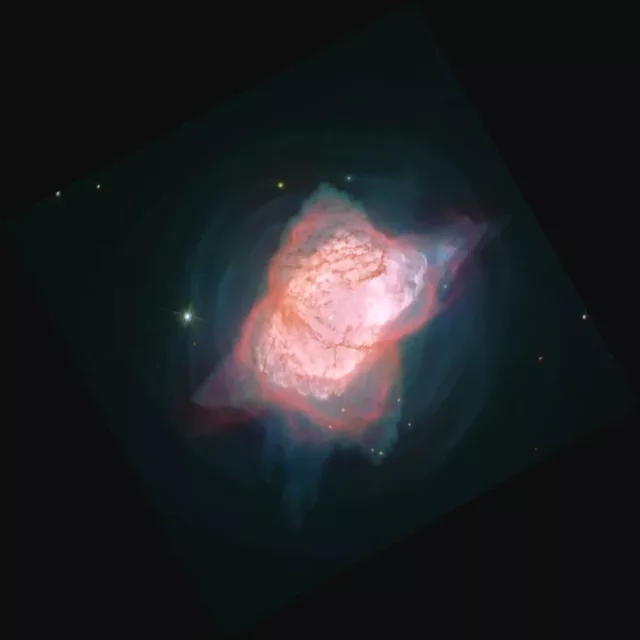
The Jewel Bug Nebula (NGC 7027), image: Judy Schmidt (from the Hubble Legacy Archive, CC0 1.0)
Location
NGC 7027 lies in the same region of the sky as the North America Nebula (NGC 7000) and the Pelican Nebula (IC 5070), two large emission nebulae located in the region around the Northern Cross in Cygnus. The Jewel Bug is located 5.5 degrees southeast of Deneb, the brightest star in Cygnus and the 19th brightest star in the sky.
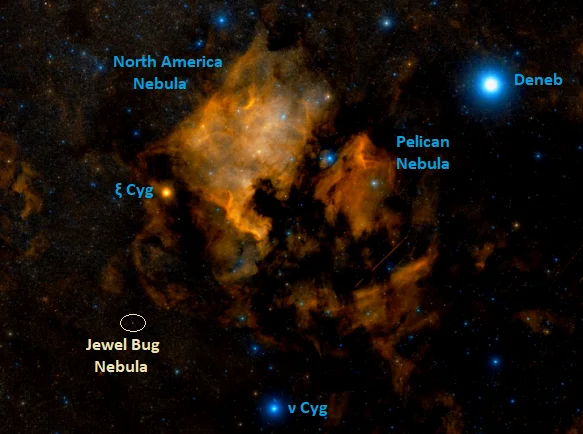
Jewel Bug, North America and Pelican nebulae, image: Wikisky
Deneb is easily found because it sits at the top of the Northern Cross, an asterism that dominates the northern summer sky. The star is also part of the Summer Triangle, another prominent northern asterism formed by Deneb with Vega in the constellation Lyra and Altair in Aquila.
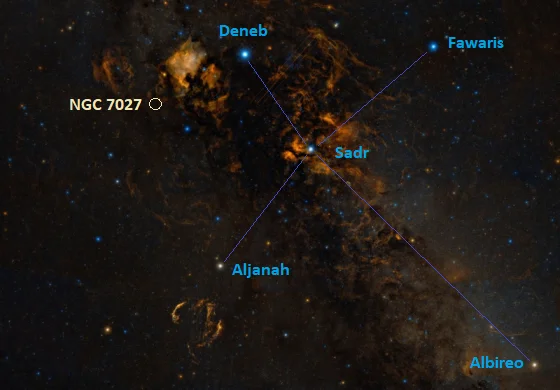
The location of NGC 7027, image: Wikisky
The best way to observe the Jewel Bug Nebula is in larger telescopes, at the highest possible magnifications. In 4-inch telescopes, the nebula only appears as an enlarged star at moderate magnifications, while higher magnifications reveal a dumbbell-like shape.
Jewel Bug Nebula – NGC 7027
| Constellation | Cygnus |
| Right ascension | 21h 07m 01.7s |
| Declination | +42° 14’ 11’’ |
| Apparent size | 16’’ by 12’’ |
| Dimensions | 0.2 by 0.1 light years |
| Age | 600 years |
| Mass | 3 – 4 M☉ |
| Apparent magnitude | 10 |
| Distance | 2,870 light years (880 parsecs) |
| Designations | NGC 7027, AG+42 1976, BD+41 4004, BWE 2105+4201, F3R 2778, GCRV 13282, HD 201272, SAO 50463, GSC 03176-00798, NVSS J210701+421409, PLX 5083.00, PK 084-03 1, PN G084.9-03.4, PN VV’ 543, PN VV 261, PN ARO 40, WN B2105.1+4202 |